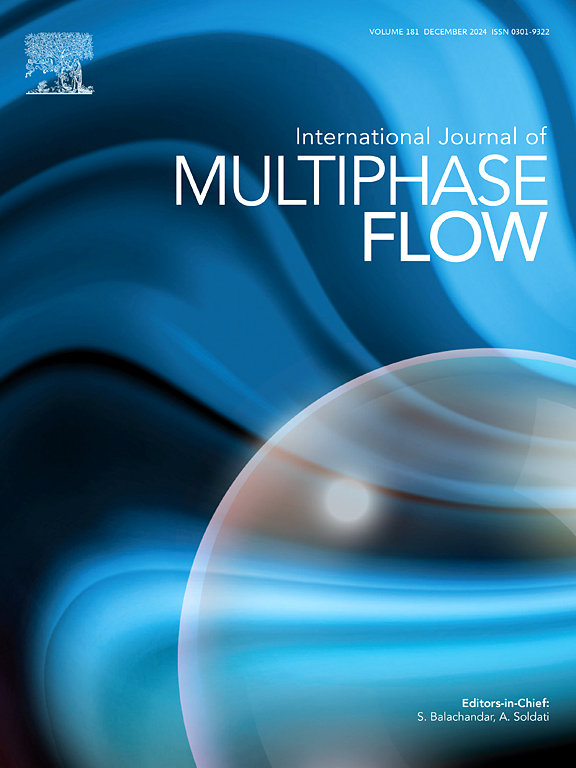Modeling droplet size distributions in flashing sprays with 3D LES using an enhanced ELSA approach
IF 3.8
2区 工程技术
Q1 MECHANICS
International Journal of Multiphase Flow
Pub Date : 2025-07-19
DOI:10.1016/j.ijmultiphaseflow.2025.105356
引用次数: 0
Abstract
Flashing sprays play a critical role in high-altitude propulsion systems, where rapid phase transitions and complex transonic effects govern spray breakup and droplet formation. This study applies a novel Flashing Liquid Atomization Model (FLAM), within a hybrid Eulerian–Lagrangian framework to predict droplet size distributions at spray breakup. The governing equations of a one-fluid formulation for two-phase flows are solved on the Eulerian grid, while post-breakup droplets are tracked as Lagrangian particles. By incorporating surface density transport, the FLAM model eliminates the need to predefine droplet properties, instead providing locally determined droplet diameters. The droplet evaporation process is modeled as a combination of flash evaporation and diffusion, accounting for injection into conditions below the triple point. The approach is validated against experimental data from liquid nitrogen injection in near-vacuum conditions. Results reveal circumferential inhomogeneities in droplet size distributions, challenging the assumption of uniform atomization in flashing sprays. The three-dimensional Large Eddy Simulations (LES) capture turbulence-driven droplet collisions and shock-induced surface density destruction, leading to a more uniform droplet distribution while preserving the qualitative trends observed in previous two-dimensional Reynolds-Averaged Navier–Stokes (RANS) investigations. This study highlights the importance of capturing localized breakup physics for accurately modeling flashing sprays. The findings provide new insights into the interplay of phase change, turbulence, and transonic effects in cryogenic jet injection, contributing to the advancement of hybrid Eulerian–Lagrangian spray modeling for high-altitude propulsion systems.

使用增强ELSA方法的3D LES模拟闪光喷雾中的液滴尺寸分布
在高空推进系统中,快速的相变和复杂的跨音速效应控制着喷雾的破裂和液滴的形成,闪光喷雾起着至关重要的作用。本研究采用一种新型的闪烁液体雾化模型(FLAM),在混合欧拉-拉格朗日框架内预测喷雾破碎时液滴的尺寸分布。在欧拉网格上求解单流体两相流的控制方程,并将破碎后的液滴作为拉格朗日粒子进行跟踪。通过结合表面密度传输,FLAM模型无需预先定义液滴特性,而是提供局部确定的液滴直径。液滴蒸发过程被建模为闪蒸和扩散的结合,考虑到在三相点以下的条件下注入。通过近真空条件下液氮注入实验数据验证了该方法的有效性。结果揭示了液滴尺寸分布的周向不均匀性,挑战了闪烁喷雾均匀雾化的假设。三维大涡模拟(LES)捕获了湍流驱动的液滴碰撞和激波诱导的表面密度破坏,使得液滴分布更加均匀,同时保留了之前二维reynolds -平均Navier-Stokes (RANS)研究中观察到的定性趋势。这项研究强调了捕捉局部破碎物理对于精确建模闪光喷雾的重要性。这些发现为低温喷射中相变、湍流和跨音速效应的相互作用提供了新的见解,有助于推进高空推进系统的欧拉-拉格朗日混合喷雾建模。
本文章由计算机程序翻译,如有差异,请以英文原文为准。
求助全文
约1分钟内获得全文
求助全文
来源期刊
CiteScore
7.30
自引率
10.50%
发文量
244
审稿时长
4 months
期刊介绍:
The International Journal of Multiphase Flow publishes analytical, numerical and experimental articles of lasting interest. The scope of the journal includes all aspects of mass, momentum and energy exchange phenomena among different phases such as occur in disperse flows, gas–liquid and liquid–liquid flows, flows in porous media, boiling, granular flows and others.
The journal publishes full papers, brief communications and conference announcements.

 求助内容:
求助内容: 应助结果提醒方式:
应助结果提醒方式:


